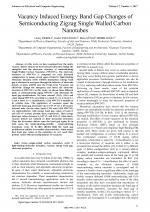| 3/2017 - 2 |
Vacancy Induced Energy Band Gap Changes of Semiconducting Zigzag Single Walled Carbon NanotubesDERELI, G. |
| Extra paper information in |
| Click to see author's profile in |
| Download PDF |
Author keywords
single-walled carbon nanotubes, order N tight-binding molecular dynamics, vacancy, energy band gap, electronic properties
References keywords
carbon(29), nanotubes(21), single(11), tight(10), binding(10), walled(8), properties(8), molecular(8), electronic(8), dynamics(7)
Blue keywords are present in both the references section and the paper title.
About this article
Date of Publication: 2017-08-31
Volume 17, Issue 3, Year 2017, On page(s): 11 - 18
ISSN: 1582-7445, e-ISSN: 1844-7600
Digital Object Identifier: 10.4316/AECE.2017.03002
Web of Science Accession Number: 000410369500002
SCOPUS ID: 85028550042
Abstract
In this work, we have examined how the multi-vacancy defects induced in the horizontal direction change the energetics and the electronic structure of semiconducting Single-Walled Carbon Nanotubes (SWCNTs). The electronic structure of SWCNTs is computed for each deformed configuration by means of real space, Order(N) Tight Binding Molecular Dynamic (O(N) TBMD) simulations. Energy band gap is obtained in real space through the behavior of electronic density of states (eDOS) near the Fermi level. Vacancies can effectively change the energetics and hence the electronic structure of SWCNTs. In this study, we choose three different kinds of semiconducting zigzag SWCNTs and determine the band gap modifications. We have selected (12,0), (13,0) and (14,0) zigzag SWCNTs according to n (mod 3) = 0, n (mod 3) = 1 and n (mod 3) = 2 classification. (12,0) SWCNT is metallic in its pristine state. The application of vacancies opens the electronic band gap and it goes up to 0.13 eV for a di-vacancy defected tube. On the other hand (13,0) and (14,0) SWCNTs are semiconductors with energy band gap values of 0.44 eV and 0.55 eV in their pristine state, respectively. Their energy band gap values decrease to 0.07 eV and 0.09 eV when mono-vacancy defects are induced in their horizontal directions. Then the di-vacancy defects open the band gap again. So in both cases, the semiconducting-metallic - semiconducting transitions occur. It is also shown that the band gap modification exhibits irreversible characteristics, which means that band gap values of the nanotubes do not reach their pristine values with increasing number of vacancies. |
| References | | | Cited By |
Web of Science® Times Cited: 3 [View]
View record in Web of Science® [View]
View Related Records® [View]
Updated 2 weeks, 5 days ago
SCOPUS® Times Cited: 5
View record in SCOPUS® [Free preview]
View citations in SCOPUS® [Free preview]
[1] Band-gap tuning of graphene by Mg doping and adsorption of Br and Be on impurity: A DFT study, Tayyab, Muhammad, Hussain, Akhtar, Asif, Qurat ul Ain, Adil, Waqar, Computational Condensed Matter, ISSN 2352-2143, Issue , 2020.
Digital Object Identifier: 10.1016/j.cocom.2020.e00469 [CrossRef]
[2] Band-gap engineering of graphene by Al doping and adsorption of Be and Br on impurity: A computational study, Tayyab, Muhammad, Hussain, Akhtar, Adil, Waqar, Nabi, Shafqat, Asif, Qurat ul Ain, Computational Condensed Matter, ISSN 2352-2143, Issue , 2020.
Digital Object Identifier: 10.1016/j.cocom.2020.e00463 [CrossRef]
[3] Work function, carrier type, and conductivity of nitrogen-doped single-walled carbon nanotube catalysts prepared by annealing via defluorination and efficient oxygen reduction reaction, Yokoyama, Koji, Sato, Yoshinori, Yamamoto, Masashi, Nishida, Tetsuo, Motomiya, Kenichi, Tohji, Kazuyuki, Sato, Yoshinori, Carbon, ISSN 0008-6223, Issue , 2019.
Digital Object Identifier: 10.1016/j.carbon.2018.10.052 [CrossRef]
[4] Identification of vacancy defects in carbon nanotubes using vibration analysis and machine learning, Singh, Sneha, Junaid, Zaid Bin, Vyas, Vinay, Kalyanwat, Teekam Singh, Rana, Subhram Subhrajyoti, Carbon Trends, ISSN 2667-0569, Issue , 2021.
Digital Object Identifier: 10.1016/j.cartre.2021.100091 [CrossRef]
[5] Controllable synthesis of defective carbon nanotubes/Sc2Si2O7 ceramic with adjustable dielectric properties for broadband high-performance microwave absorption, Wei, Hanjun, Yin, Xiaowei, Li, Xin, Li, Minghang, Dang, Xiaolin, Zhang, Litong, Cheng, Laifei, Carbon, ISSN 0008-6223, Issue , 2019.
Digital Object Identifier: 10.1016/j.carbon.2019.03.008 [CrossRef]
Disclaimer: All information displayed above was retrieved by using remote connections to respective databases. For the best user experience, we update all data by using background processes, and use caches in order to reduce the load on the servers we retrieve the information from. As we have no control on the availability of the database servers and sometimes the Internet connectivity may be affected, we do not guarantee the information is correct or complete. For the most accurate data, please always consult the database sites directly. Some external links require authentication or an institutional subscription.
Web of Science® is a registered trademark of Clarivate Analytics, Scopus® is a registered trademark of Elsevier B.V., other product names, company names, brand names, trademarks and logos are the property of their respective owners.
Faculty of Electrical Engineering and Computer Science
Stefan cel Mare University of Suceava, Romania
All rights reserved: Advances in Electrical and Computer Engineering is a registered trademark of the Stefan cel Mare University of Suceava. No part of this publication may be reproduced, stored in a retrieval system, photocopied, recorded or archived, without the written permission from the Editor. When authors submit their papers for publication, they agree that the copyright for their article be transferred to the Faculty of Electrical Engineering and Computer Science, Stefan cel Mare University of Suceava, Romania, if and only if the articles are accepted for publication. The copyright covers the exclusive rights to reproduce and distribute the article, including reprints and translations.
Permission for other use: The copyright owner's consent does not extend to copying for general distribution, for promotion, for creating new works, or for resale. Specific written permission must be obtained from the Editor for such copying. Direct linking to files hosted on this website is strictly prohibited.
Disclaimer: Whilst every effort is made by the publishers and editorial board to see that no inaccurate or misleading data, opinions or statements appear in this journal, they wish to make it clear that all information and opinions formulated in the articles, as well as linguistic accuracy, are the sole responsibility of the author.



